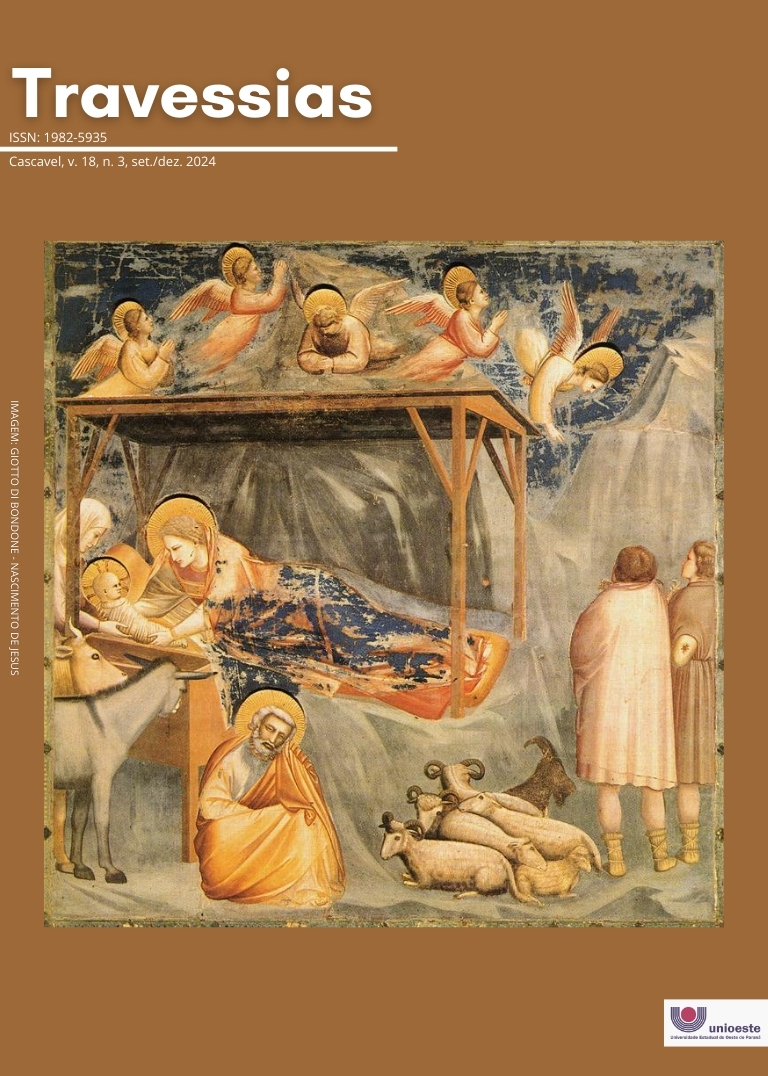Parody and irony
transgressive appropriation of the biblical text in “A paixão Segundo G.H.”, by Clarice Lispector
DOI:
https://doi.org/10.48075/rt.v18i3.34315Keywords:
Brazilian Literature, Clarice Lispector, A paixão segundo G.H., Parody, IronyAbstract
It is common sense to identify theorists who dedicate themselves to the study of Clarice Lispector's work, especially in relation to the presence of some Western and Eastern religions in The Passion According to G.H. However, this article proposes to identify, particularly, the appropriation of the biblical text in this specific work, as well as the transgressive way, with rare exceptions, in which the narrator character of the novel uses this religious text, shamelessly subverting it through parody and irony. Therefore, the methodology is qualitative and is based on the use of theoretical and critical texts aiming at the method of data collection of the material selected for carrying out the textual analysis. Therefore, the attempt is to identify the most relevant biblical excerpts applied to the texture of the text and, in addition, to address how parody and irony compose it and how Lispector constructs her protagonist character G.H. and the literary narrative. Furthermore, in this novel, Lispector explores imaginary and subjective dimensions of the biblical text and, above all, provides the subject's place to the language that creates around itself a labyrinth whose final destination is found in its core, its interior. To this end, the authors used are: Antonio Candido (2009), Benedito Nunes (1969; 1973; 1995), Maria José Barbosa (2001), Rodrigo Guimarães (2010), Linda Hutcheon (1985; 2000), among others. The narrative initially revolves around the ritual of tidying up that the character performs in her apartment, and yet, in this one perceives the metaphor of pilgrimage and ascension of an introspective order. Therefore, in the maid's room, the first room to be organized, G.H. she is faced with a cockroach, an ancestral animal that connects and establishes an initiatory point for a long stage of reflection and flow of consciousness for the protagonist, as it is the beginning of a new time, a cycle of discoveries before the world and, above all, within herself.
Downloads
References
ARÊAS, Vilma. Clarice Lispector: com a ponta dos dedos. São Paulo: Companhia das Letras, 2005.
ARFUCH, Leonor. O Espaço Autobiográfico. Rio de Janeiro: EDUERJ, 2010.
BARBOSA: Maria José Somerlate. Clarice Lispector: desfiando as teias da Paixão. Porto Alegre; EDIPUC-RS, 2001.
BÍBLIA SAGRADA. Traduzida da vulgata e anotada pelo Pe. Matos Soares. 19. ed. São Paulo: Edições Paulinas, 1964.
CANDIDO, Antonio. A educação pela noite e outros ensaios. 2. ed. São Paulo: Ática, 1989.
GUIMARÃES, Rodrigo. “E” (Ensaios de literatura e filosofia). Rio de Janeiro: 7 Letras, 2010.
HUTCHEON, Linda. Teoria e política da ironia. Tradução de Julio Jeha. Belo Horizonte: Editora da UFMG, 2000.
HUTCHEON, Linda. Uma teoria da paródia. Rio de Janeiro: Edições 70, 1985.
LISPECTOR, Clarice. A paixão segundo G.H. São Paulo: Rocco, 2009.
NUNES, Benedito. Leitura de Clarice Lispector. São Paulo: Quíron, 1973.
NUNES, Benedito. O Dorso do Tigre. São Paulo; Perspectiva, 1969.
NUNES, Benedito. O Drama da Linguagem: Uma leitura de Clarice Lispector. Ática; São Paulo, 1995.
Downloads
Published
How to Cite
Issue
Section
License
Copyright (c) 2024 Authors keep the copyright and grant the journal the right of first publication, with the work simultaneously licensed under the Creative Commons Attribution License (CC-BY-NC-SA 4.0), which allows sharing the trial with acknowledgment of authorship and initial publication in this journal.

This work is licensed under a Creative Commons Attribution-NonCommercial-ShareAlike 4.0 International License.
Creative Copyright Notice
Policy for Free Access Journals
Authors who publish in this journal agree to the following terms:
1. Authors keep the copyright and grant the journal the right of first publication, with the work simultaneously licensed under the Creative Commons Attribution License, which allows sharing the trial with acknowledgment of authorship and initial publication in this journal.
2. Authors are authorized to take additional contracts separately, for non-exclusive distribution of the work version, published in this journal (eg publish in institutional repository or as a book chapter), with acknowledgment of authorship and initial publication in this journal.
3. Authors are allowed and encouraged to publish and distribute their work online (eg in institutional repositories or on their personal page) at any point before or during the editorial process, as this can generate productive changes, as well as increase both impact and citation of the published trial (See The Effect of Free Access).
Creative Commons License
This work is licensed under a Creative Commons Attribution–NonCommercial-shareaswell 4.0 International License, which allows you to share, copy, distribute, display, reproduce, completely or part of the work, since there is no commercial purpose, and authors and source are cited.



